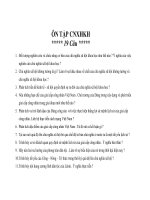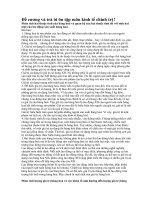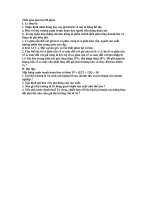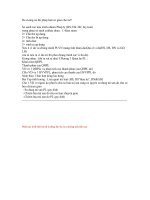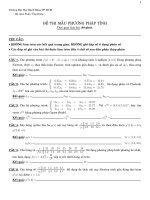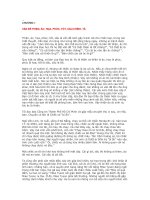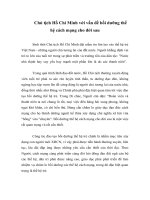de kiemn
Bạn đang xem bản rút gọn của tài liệu. Xem và tải ngay bản đầy đủ của tài liệu tại đây (192.62 KB, 16 trang )
<span class='text_page_counter'>(1)</span>Week: 7 Period:20. UNIT 4. Date: 16/ 10/2016. OUR PAST. Lesson1 : GETTING STARTED + LISTEN & READ+ L F 1,2 A-Objectives : By the end of the lesson , students will be able to tell the activities people used to do in the past. B-Language contents : - Grammar : - Simple past / used to + V - Vocabulary : - equipment , a folktale , traditional , great grandma , (to) light C-Teaching aids : - Textbook , posters , pictures , cards , cassette player D- Procedures : I -Check up : 3’Control the exercises II-Warm up : 3’ Pelmanism run fly take go have do be ride eat sit come flew went did rode sat came ran had was/ ate took were III-New lesson:38’ Teacher’s and Students’ activities. Contents.
<span class='text_page_counter'>(2)</span> Ask Ss to look at the 1/ Getting Started: pictures on page 38 and Write the names of the things that do not belong to the pas write the names of the things Answer keys: that do not belong to the past - The TV - The radio - The mobile phone - The light fixture + Pre reading: - Modern clothing/ school uniform 2/ Vocabulary: - (to) look after [luk ':ftə] : chăm sóc - Eliciting. (synonym) -Modelling - an equipment [i'kwipmənt] : thiết bị - Recording. (example) - traditional [trə'di∫ənəl] (adj): truyền thống (translation) - a great grandmother ['greit'grændm đə] : bà cố (explanation) - a folktale ['foukteil] : chuyện cổ tích conversation (n) [,k nvə'sei∫n] cuộc nói chuyện, đàm phán . Check: What and Where. look after equipment traditional great grandma + While reading: 3/ True - False statements: Ask students to read the a) Nga used to live on a farm. statements (on poster) and b) Nga’s grandma didn’t go to school. predict . c) She has an easy and happy life when she was young. Ask students to read the d) There wasn’t any modern equipment at her time. dialogue between Nga and e) “The lost shoe” is a short story. her Grandma and check Answer keys: their prediction. a) F b) T c) F d) T e) F Ask them to correct the a) Grandma used to live on a farm. false statements. c) She has a hard life. Give feedback. e) “The lost shoe” is an old folk tale. Get students to work in 4/ Answer the questions: pairs,asking and answering a) Where did Nga’s grandmother use to live? questions. => She used to live on a farm. Give feedback. b) Why didn’t she go to school? => Because she had to stay at home and help her Mom.
<span class='text_page_counter'>(3)</span> Have students read the statements part 3 on page 39 and decide which is fact and which is an opinion. Give feedback.. + Post reading: Revision of Past Simple Tense. . Set the scene: Lan asks Nga about Nga’s yesterday activities.. look after her younger brothers and sisters. c) What did Nga’s great Grandma do? => She used to cook the meals, clean the house and was the clothes. d) What did Nga’s great grandma and great grandfather d after dinner? => Her great grandma used to lit the lamp and her gre grandfather used to tell stories. e) What did Nga ask her grandma to do at the end of t conversation? => She asked her grandma to tell her the tale “The lo shoe”. 5) Fact or Opinion: a) I used to live on a farm. b) There wasn’t any electricity. c) Mom had to do everything without the help of mode equipment. d) My father used to tell us stories. e) The best one was The Lost Shoe. f) Traditional stories are great. Answer keys: a) F b) F c) F d) F e) O f) O 6/ Mapped dialogue: Lan Nga - …….. lunch? - No. I ate noodles. - How …… school? - I …… bike to school. - Which subject …… ? - …… Math. - When …… yesterday evening? - …… home. Answer keys: Lan: Did you eat rice for noodle? Nga: No. I ate noodle. Lan: How did you get to school? Nga: I rode a bike to school. Lan: Which subject did you have yesterday? Nga: I had Math. Lan: When were you yesterday evening?.
<span class='text_page_counter'>(4)</span> Nga: I was at home. IV-Homework :1’ - Learn new words by heart -Read the dialogue - Answer the questions - Prepare “ Speak’’ + L F4 E.Evaluation :.................................................................................................. ........................................................................................................................... ................................... Week:7 Period: Date: 16 /10 /2016. UNIT 4 Lesson 2 :. 21. OUR PAST SPEAK +L. F 4. A-Objectives : By the end of the lesson , students will be able to talk about difference between life in the past and that at present ; use : used to “ and the present simple . B- Language contents : - Grammar :- Used to / present simple - Vocabulary : - about life in the past and present C-Teaching aids : -Textbook , posters , pictures , cards …. D- Procedures : I-Check up : 3’ Read dialogue ; answer the questions II-Warm up:3’ Jumble words III-New lesson:38’ Teacher’s and Students activities + Warm up:. Contents 1/ Jumble words: a) rieletcicty = electricity b) menttaenterin = entertainment.
<span class='text_page_counter'>(5)</span> + Presentation: Recall the conversation between Nga and her grandma, then ask: “Where did Nga’s grandma always live?” - “She always lived on a farm.” Ask: “ Another word for always lived.” - Answer: “Used to live.” Ask students to use USED TO to make question and answer. + Practice: Get students to work in open pairs then closed pairs.. + Production: - Get students to work in open pairs then closed pairs. Compare two pictures on page 40, using “USED TO” to talk about the actions in the past. -Elicit some ideas so that students can talk about them.. c) rkmaet d) permasuekt. = market = supermarket 2/ Model sentences: a) Model sentence: - “Where did Nga’s grandma use to live?” + “She used to live on a farm.” b) Form: (+) S + USED TO – infinitive …… (-) S + didn’t USE TO – infinitive …… (?) Did + S + USE TO – infinitive …… ? c) Use: USED TO express a past habit, or an action usual happened in the past. d) Meaning: Đã thường hay làm gì 3/ Word cue drill: a) live/ Hue/ Ha Noi - Did you use to live in Hue? => No. I used to live in Ha Noi. b) have/ long hairs/ short hairs - Did you use to have long hairs? => No, I used to have short hairs. c) get up/ late/ early - Did you use to get up late? => No. I used to get up early. d) walk to school/ bike - Did you use to walk to school? => No. I used to go to school by bike. e) study/ evening/ early morning - Did you use to study in the evening? => No. I used to study in the early morning. 4/ Speaking: a) Where did they live in the past? And now? -People used to live in small houses. Now they live in b houses and buildings. b) How did they travel? -People used to walk.Now,they can go by cars or motorbike c) What’s about the electricity? -Now, there is electricity everywhere. d) What’s about their life/ work? - People used to work hard all the time. Now, they have a l of time for entertainment..
<span class='text_page_counter'>(6)</span> Ask students to do exercise 4 on page 45. Have students work in pairs, looking at 4 pictures; using USED TO with the verbs live - stay - have - be to complete the dialogue between Nga and Hoa. Give feedback.. e) Did children use to go to school? => Most children used to stay at home. Now, they all go school. f) What’s about their entertainment? => Children used to play traditional games such as hide an sick, skip rope …… outdoors. Now, they have a lot modern games - video games. 5/ Complete the dialogue: Nga: Where is it? It isn’t Ha Noi. Hoa: No, it’ Hue. I used to stay there. Nga: Is that you, Hoa? Hoa: Yes. I used to have long hairs. Nga: Who is in this photos? Hoa: That is Loan. She used to be my next door neighbor. Nga: Are they your parents? Hoa: They’re my aunt and uncle. They used to live in Hu too.. IV- Homework:1’ - Write what you used to do last year ( about 8 sentences ) - Prepare “ Listen’’ E.Evaluation: ................................................................................................. ........................................................................................................................... ........................................................................ Date: 23/10/2016 Week: 8 Period: 22. UNIT 4 Lesson 3 :. OUR PAST LISTEN. A-Objectives : - By the end of the lesson , students will be able to listen to a story to draw out a moral lesson . B- Language contents :.
<span class='text_page_counter'>(7)</span> - Grammar : - past simple - Vocabulary : - ( to ) lay , (to) discover , a gold egg , foolish , greedy C-Teaching aids: -Textbook , posters , pictures , cards , cassette player D- Procedures I-Check up : 3’ -Answer the questions -What did you use to do last year ? -Look at the picture .Talk about the actions in the past and in present II-Warm up : 3’ Pelmanism III-New lesson :38’ Teacher’s and Students’ Contents activities + Warm up: 1/ Pelmanism: run ran fly flew ride rode eat ate sit sat come came + Pre listening: 2/ Vocabulary: - foolish ['fu:li∫] (adj): ngốc nghếch - Eliciting. (translation) -Modelling - greedy ['gri:di] (adj): tham lam - Recording. (translation) - gold [gould] (n): vàng (realia) - (to) lay/ laid/ laid [lei] : đẻ, sinh sản (picture) - amazement [ə'meizmənt] (n): sự sửng sốt (translation) . Check: What and Where. 3/ Prediction: Predict the moral lesson of a) Don’t kill chickens. the story. b) Don’t be foolish and greedy. Ask students to look at c) Be happy with what you have. four titles and guess which d) It is difficult to find gold. is most suitable to the story. Give feedback. + While listening: Answer keys: Have students to listen to Don’t be foolish and greedy. the tape twice and check 4/ Listening: their predition. Tape transcript:.
<span class='text_page_counter'>(8)</span> Ask students what tense is “ Once a farmer lived a comfortable life with his family used in the story. Past His chickens laid many eggs which the farmer used to bu Simple tense. food and clothing for his family . One day, he went to collect the eggs and discovered on of the chickens laid a gold egg. He shouted excitedly to hi wife: “We’re rich!”, “We’re rich!” . His wife ran to him and they both looked at the egg in amazement. The wif wanted more., so her husband decided to cut open all th chickens and find more gold eggs. Unfortunately, h couldn’t find any eggs. When he finished all, the chicken were dead. There were no more eggs of any kind for the follish Have students listen again farmer and his greedy wife.” and try to write as many 5/ Find out the verbs in the story: verbs as possible. The Answer keys: student who more verbs get - went - were - discovered - ran - laid - looked good marks. shouted - wanted - finished - decided - couldn’t Ask students to give the 6/ Mapped dialogue: information of these verbs. Lan Nga + Post listening: - …… lunch? . Set the scene: - No. I ate noodles. Lan ask Nga about Nga’s - How …… school? yesterday activities. - I …… bike to school - Which subject …… ? - …… Math. - Where …. Yesterday evening? - ……. home. Answer keys: Lan: Did you eat rice for lunch? Nga: No. I ate noodles. Lan: How did you get to school? Nga: I rode a bike to school. Lan: Which subject did you have yesterday? Nga: I had Math. Lan: Where were you yesterday evening? Nga: I was at home. IV- Homework :1’ - Learn new words by heart - Retell a story . - Prepare : Read + L . F 3.
<span class='text_page_counter'>(9)</span> E.Evaluation: ........................................................................................................................... ...... Week:8 Period :23. Date: 23/10/2016. UNIT 4. OUR PAST. Lesson 4 :. READ + L .F 3. A-Objectives :. - By the end of the lesson , students will be able to read a fairy tale to understand the details and to use prepositions of time. B- Language contents : - Grammar : - Past simple , preposition of time - Vocabulary : - (to) do chores , rags , cruel , up set , magically,a broken heart , a fairy C-Teaching aids:. -Textbook , posters , pictures , cards …. D- Procedures:. I-Check up :3’ Retell the story II-Warm up: 4’ Brainstormimg: The folktales - One hundred - section bamboo (Cây tre trăm đốt) - Tấm Cám - The Frog Prince (Hoàng tử Cóc) - Snow White and seven Dwarfs (Bạch Tuyết và bảy chú lùn) - Seven - mile shoe (Đôi hìa bảy dặm ). III-New lesson:38’. Teacher’s and Students’ activities. Contents ). + Pre reading: - Eliciting. -Modelling - Recording.. 1/ Vocabulary: - cruel ['kruəl] (adj): tàn ác, độc ác (translation) - upset [ p'set] (adj): bực mình (synonym).
<span class='text_page_counter'>(10)</span> Check: R& Remember. . Set the scene: Before reading the story“The Lost Shoe”. Ss read the question and guess the answers. Ask students to work in group Give feedback.. - a fairy ['feəri] (n): nàng tiên (translation) - magical ['mædʒikəl] (adj): thần bí (example) - magically ['mædʒikəli] (adv): thần bí (translation) - a rag [ræg] : áo quần rách (realia) - (to) fall in love with [f :l in l v wiđ] : phải lòng ai (translation) - immediately [i'mi:djətli] (adv): ngay lập tức ( explan). 2/Pre-questions: 1-Do you know the story “ The lost shoe “ ? - Yes / No b-How many characters are there in this story ? Who are the - There are six : father , step mother , Little Pea , Stout Nut , Prince , fairy. c-Who is the main character of the story ? - Little Pea d -How is the end of the story ? -The Prince fell in love Little Pea . + While reading: 3/ Answer the questions: Have students read the a) Who was Little Pea? story “The Lost Shoe” on => She was a poor farmer’s daughter. page 41 and check their b) What did Stout Nut’s mother make Little Pea do all day? prediction.and ask them to => She made her do the chores all day. correct. c) How did Little Pea get her new clothes? Ask students to work in => Before the festival started, a fairy appeared and magic pairs answering the changed her rags into beautiful clothes. questions in exercise 2 on d) Who did the Prince decide to marry? Why? page 42. => He decided to marry Little Pea because the shoe (wh Give feedback. the Prince was keeping) fitted her. e) Is this a true story? How do you know? => ( Students answer themselves.) 4/ Gap fiing: Complete the sentences a) Little Pea’s father was a farmer. with words the story. b) Little Pea’s mother died when she was young. Ask students to work in c) Little Pea used to do housework all day after her father.
<span class='text_page_counter'>(11)</span> pairs, filling the blank with suitable words from the story. Give feedback. + Post reading: Ask students to work in pairs, telling the story again in details. They can look at the statements in the gap filling exercise and add more. + Presentation: Write some prepositions in a list on the left - hand side of the blackboard. Write the time/ date/ month … on the right - hand side of the blackboard. Give feedback. Ask students to read aloud each phrase. + Practice: Ask students to do exercise 3 on page 44 individually then compare with their partners. Give feedback.. married again. d) The Prince wanted to marry a girl from Little Pea’s villag e) Stout Nut’s mother did not make new clothes for Little Pe f) The Prince found Little Pea’s lost shoe. 5/ Retell the story: “ Little Pea’s father was a poor farmer. Unfortunately, L Pea’s mother died when she was young and her father married again. The new wife was very cruel to her and m her work all day. One day, the Prince wanted to choose a from her village. Her new mother didn’t make new clothes her, but the fairy did. She came to the festival and lost a s The Prince found her shoe and decided to marry her.” 6/ Language.Focus 3:. a/ Matching: B a. January b. November 1997 c. Wednesday d. 3 pm e. July 2nd f. 7 am and 9 am. A 1. in 2. on 3. at 4. between 5. after 6. before Answer keys: 1+ a–b 2+c–e. 3–5 –6+d 4+f. b/ Gap filling: a) I’ll see you on Wednesday. b) I’m going to Laos in January. c) We must be there between 8:30 and 9:15. d) The bank closes at 3 pm if you arrive after 3 pm the bank be closed. e) I’ll be home before seven because I want to see the s o’clock news. IV- Homework :2’ - Learn new words by heart.
<span class='text_page_counter'>(12)</span> -Do language focus 3 - Retell the story - Prepare “ Write’’ E.Evaluation: ........................................................................................................................ ........................................................................................................................... ................................................. Week:8 Period :24. UNIT 4 Lesson 5 :. Date: 23/10/2016. OUR PAST WRITE. A-Objectives : - By the end of the lesson , students will be able to write a story B- Language contents : - Grammar : - Past simple - Vocabulary : - About story “ My wisdom is here “ C-Teaching aids : -Textbook , posters , pictures , cards … D- Procedures: I-Check up :3’ -Retell the story “ The lost shoe” -Answer the questions II-Warm up: 4’ Chatting: a) Do you want to read imaginary stories?.
<span class='text_page_counter'>(13)</span> b) Name some of them. c) Which story do you like best? d) Have you ever read the story “ How the Tigers got his stripes?” III-New lesson:38’ Teacher’s and Students’ activities. + Pre writing: - Eliciting. -Modelling - Recording.. . Check: What and where. Ask students the meaning of the verbs in the box. Have students work in pairs using suitable verbs to fill in the blanks. Give feedback. Ask students to work in groups, answering the following questions. Get students to answer the questions. + While writing: Get students to do exercise. Contents 1/ Vocabulary: - wisdom ['wizdəm] (n): trí khôn, sự khôn ngoan (translation) - a stripe [straip] : sọc, dây thừng (realia) - a straw [str :] : rơm (realia) - a servant ['sə:vənt] : nô lệ, người đầy tớ (translation) - (to) escape [i’skeip] : trốn thoát (translation) - (to) graze [greiz] : gặm cỏ (picture) - (to) light/ lit/ lighted [lait] : đốt (mime) wisdom stripe straw servant escape graze light 2/ Complete the story: How the Tigers got his stripes “ One day, as a farmer was in his field and his buffalo (0) was grazing nearby, a tiger (1) appear. The tiger wanted to know why the strong buffalo was the servant and the small man (2) was the master. The farmer (3) said he had something called wisdom, but he (4) left it at home that day. He (5) went to get the wisdom, but before that he (6) tied the tiger to a tree with a rope because he didn’t want it to eat the buffalo. When he returned, the farmer brought some straw with him. He said it was his wisdom. He (7) lit the straw and the fire (8) burned the tiger. The tiger (9) escaped, but it still has black stripes from the burns today.” 3/ Answer the questions: a) Where was the man?.
<span class='text_page_counter'>(14)</span> 2. They have to imagine to be a man in order to write the story. Get students to change “the man – I, his – my”. Get students to write individually then share with their partners and correct mistakes. Take some writings to correct in front of the class. Give feedback.. => He was in his field. b) What did the buffalo do when the tiger appeared? => It grazed nearby. c) What did the tiger want to know? => The tiger wanted to know why the strong buffalo was the servant and the small man was the master. d) What did he do before going home? Why? => He tied the tiger to a tree with rope because he didn’t want it to eat the buffalo. e) What did he do when he returned? => When he returned, he lit the straw to burn the tiger. 4/ Rewrite the story: Answer keys: “ One day, as I was in a field and my buffalo grazed nearby, a tiger came. It asked why the strong buffalo + Post writing: was my servant and I was its master. I told tiger that I had They work in team, telling something called wisdom. The tiger wanted to see it but I said the story . Ask a volunteer that I left the wisdom at home that day. Then I tied the tiger from each team to tell the to a tree with a rope because I didn’t want it to eat my story in front of the class. buffalo. I went to get some straw and I burned the tiger. The tiger escaped, but today it still has black stripes from the burn.” 5/ Tell the story: a) The tiger - I b) The buffalo - I V–Homework:2’ - Learn new words by heart - Rewrite the story by your own words - Tell the story - Prepare ( correction a test) E.Evaluation: ................................................................................................................................................ ................................................................................................................................................ ....... Week: 9 Period :25. Date: 30 / 10 / 2016. TEST CORRECTION.
<span class='text_page_counter'>(15)</span> A. Objectives: By the end of the lesson, students will be able to correct mistakes and consolidate knowledge. B. Procedures: Teacher’s and Students’ Contents activities 1.Warm up: (3’) Sing an English song .Activity1: (10’) Hand out ss’ tests Have ss look at their tests carefully. Give some sentences that have common mistakes in each part.. 3.Activity2: (10’) Have ss swap their tests and correct in pair. 4.Activity3: (10’) T asks Ss read the text again Ss do exercises. Feedback. * Self – correction: A. LISTENING: I. Listen and tick True(T) or False(F)(1.5ms) 1. T 2.T 3.F 4.F 5.F 6.T II. Listen and complete the table. ( 1,0m) 1. 149.6 2. 57.9 3. 142,796 4. 12,104 B.VOCABULARY AND GRAMMAR: I. Choose the best answer to fill in the blanks. (1.5ms) 1. old enough 2.in 3.is 4. short yellow 5. himself 6. to learn II.Supply the correct word form. (1m) 1. dangerous 2. electrical 3. locked 4.destroyment C.READING: I.Read the passage and choose True or False (1 m): 1. F 2. F. 3.T. 4. F. II. Read the passage carefully and questions: (1.5) 1. He was born in 1847. 2. He went to America. 3. He taught in a school for the deaf.. answer the.
<span class='text_page_counter'>(16)</span> 5.Activity3: (10’) T gives some exercises. Ss do exercises. Feedback 6.Home work: (2’) - Prepare unit 5 Leson 1 Getting started+ Listen and read. 4. He began work on a new invention. 5.No, he didn’t. 6.He was born in Edinburgh, Scotland. D.WRITING: I.Circle the best option A,B.C or D from the cues given.(1.m) 1.B 2.D 3.A 4.A II.Write the sentences using word cues(1m) 1. She has long black hair. 2. He is old enough to go to school 3.The knives are on the wall and beneath the cupboard 4. We enjoy telling jokes. 5.He enjoys reading comics. 6. In the middle of the kitchen, there is a table and four chairs.
<span class='text_page_counter'>(17)</span>
